Explore Stylish Tile Ideas for Your Laundry Room
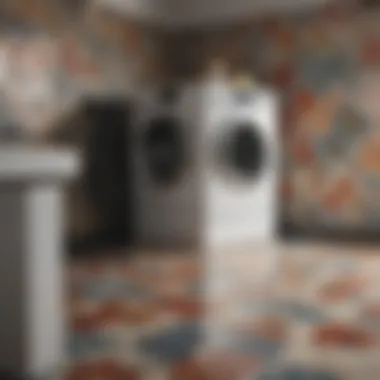
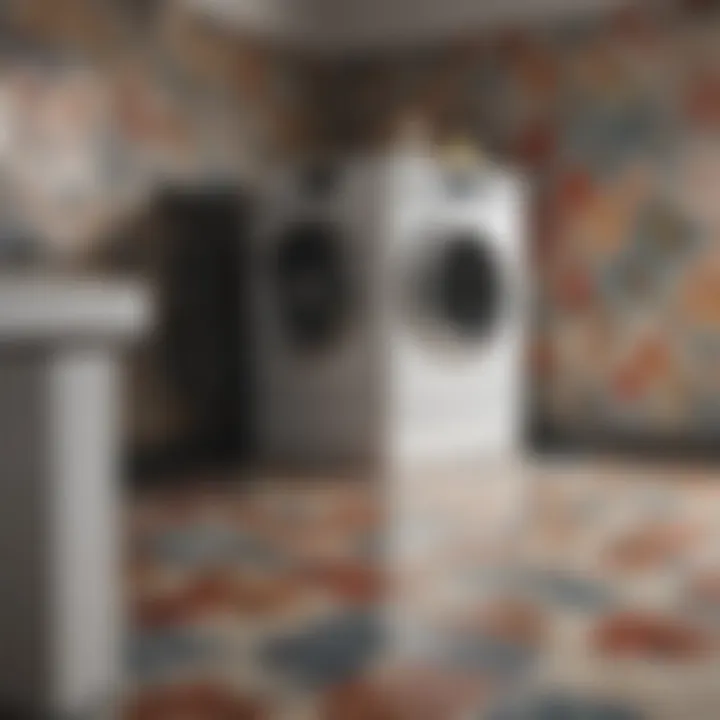
Intro
Laundry rooms often serve a dual purpose: they are functional spaces for chores and can also reflect a homeowner's personal style. Choosing the right tile can significantly influence both the usability and aesthetic appeal of this area. With the variety of materials available, understanding their specific characteristics helps in making an informed decision.
This article will take you through various tile options, each with its benefits along with practical considerations. The aim is to guide homeowners step-by-step through the process of planning, selecting, and installing tiles in their laundry rooms, ensuring a balance between functionality and style.
Materials:
When preparing for a tile project in your laundry room, gathering all necessary materials is vital. Here’s what you'll need:
- Tiles: Considerations include size, material (ceramic, porcelain, or eco-friendly options), and color. Generally, a common size for laundry room tiles is 12x24 inches.
- Thin-set mortar: A bag usually covers about 40 square feet.
- Grout: Choose the color that complements your tiles. One bag generally covers around 150 square feet.
- Tile spacers: Typically, 1/16 to 1/8 inch for proper spacing.
- Tile cutter: Depending on room size and tile material.
- Trowel: Notching will help in even mortar application (1/4 inch notch recommended).
- Sealer: For certain tiles, using a sealant could be beneficial for long-term preservation.
Example Measurements:
- Room size: For a small laundry room, aim for approximately 70 square feet.
- Tile count estimation: For 12x24 tiles, you might need about 30 tiles for a typical area (adding 10% allowance for cuts).
DIY Steps:
Step One: Planning the Layout
Start by measuring your room's dimensions, including any built-in cabinets or appliances. Plan the layout beforehand, ensuring alignment and minimizing cuts wherever possible.
Step Two: Preparing the Subfloor
Ensure your subfloor is clean, dry, and structurally sound. Remove any old flooring if necessary.
Step Three: Installing the Tiles
- Mix the thin-set mortar according to package instructions.
- Using the trowel, spread a thin layer of mortar on a small area of the floor.
- Begin placing tiles, using spacers to maintain even gaps.
- Repeat until the area is covered.
Step Four: Grouting
- Once the mortar sets (usually 24 hours), remove spacers and mix grout.
- Push grout into the spaces between the tiles, using a float for even coverage.
- Wipe off excess grout with a damp sponge.
- Allow to cure as specified.
Step Five: Sealing (if necessary)
After the grout has set and dried for a few days, apply a sealer for added protection against stains and moisture.
Technical Aspects:
Understanding the right tools and technique makes tackling a tile project smoother. Here’s a useful list of tools for a smooth execution:
- Tile cutter or wet saw
- Notched trowels for proper mortar application
- Grout float for grouting tasks
- Magic eraser to clean spilled grout instantly
- Rubber mallet to adjust tiles if needed
Timing is important. Expect to devote about one weekend for installation and additional time for curing and sealer application.
Troubleshooting Tips:
Tile installation can present challenges. Here are common issues and solutions:
- Uneven tile surfaces: Ensure the subfloor is leveled before starting.
- Grout haze: Clean tiles adequately after grouting but avoid adding too much water.
- Chipped tiles: Careful cutting and installation are paramount; consider a backup tile in case of errors.
Transforming your laundry room with tiles can provide both functionality and aesthetic improvements. With careful planning and execution, you will achieve professional results.
Continue enhancing your laundry space feel by using a variety of colors and patterns, ensuring the room encapsulates your personal style while remaining practical.
Prelude to Laundry Room Tiles
When designing or renovating your laundry room, selecting the right tiles is crucial. Tiles not only contribute to the room's functionality but also enhance its aesthetic appeal. They need to withstand the regular wear and tear of a busy home while offering comfort and style. 理解 the different tile options available allows homeowners to make informed choices that align with their preferences and practical needs.
Importance of Tile Selection
The significance of tile selection extends beyond mere appearance. An adequate choice of tile can alter how a laundry room performs. Tiles are often exposed to water, detergent spills, and high moisture levels. Selecting suitable materials and styles can prevent damage over time and support easy maintenance. The consequences of improper tile choice might lead to unsightly stains, slips, or costly repairs.
Therefore, tile selection plays a pivotal role in achieving both functionality and visual harmony within the laundry space. The end result—is a laundry room that is not only practical but also enjoyable to spend time in.
Factors to Consider in Tile Options
In choosing tiles for a laundry room, several key factors should be taken into account. Should prioritize durability, water resistance, and ease of maintenance. Understanding these factors ensures that the selected tiles perform well in the challenging environment of a laundry space.
Durability
Durability is vital for workspaces like laundry rooms. Tiles encounter various conditions, including frequent foot traffic, potential water exposure, and detergent spills. Materials designed for high durability can handle these stresses without chipping or cracking easily. Porcelain and ceramic tiles are excellent options. They resist fading and scratching, making them suited for this environment. The long-lasting nature of durable tiles can also reduce the need for frequent replacements, leading to long-term cost savings.
Water Resistance
Water resistance is another decisive factor in tile selection for laundry rooms. Water-resistant tiles help to create a safer and more practical environment. These tiles can handle significant humidity and moisture without deteriorating or warping. Porcelain tiles offer exceptional water resistance, thereby reducing the risk of mold and water damage. Homeowners should avoid materials that can absorb water since these can lead to serious structural issues later.
Easy Maintenance
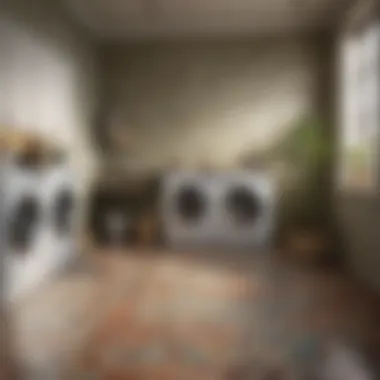
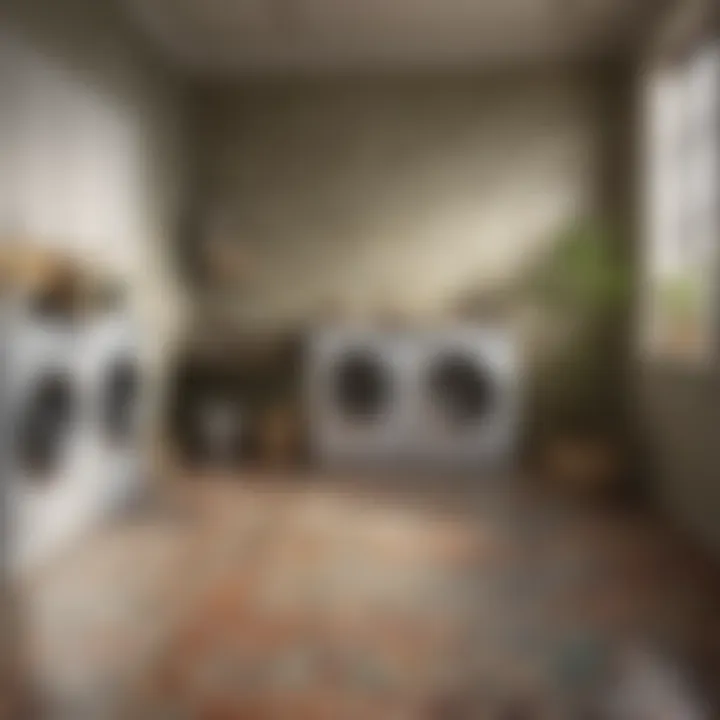
Easy maintenance is an essential characteristic when it comes to tiles in practical spaces like laundry rooms. Nobody wants to spend excessive time cleaning when there are better things to do. Tiles that are easy to clean and maintain contribute to a more functional and enjoyable environment. Smooth surfaces are easier to wipe down, while non-porous tiles resist stains more effectively. Regular epoxy grout can also be a good choice, which allows for easier cleaning and fewer stains over time
Types of Tiles for Laundry Rooms
Choosing the right type of tile for your laundry room is crucial. Laundries face high moisture levels and require materials that can handle such conditions. In addition to durability, tiles come in many styles and designs that can enhance the overall aesthetic of the space. Understanding the different types of tiles provides homeowners with the ability to select products that meet both functional and design needs.
Ceramic Tiles
Style Variations
Ceramic tiles are a popular choice, known for their versatility. Within this category, there exists a multitude of styles—from glossy to matte finishes. These variations can greatly affect the room's atmosphere. Homeowners can opt for intricate designs or stick with solid color options depending on personal preference.
This stylistic flexibility is a key characteristic of ceramic tiles. Their ability to mimic other materials, such as wood or stone, makes them appealing to a wide audience. However, glossy tiles may be less forgiving in highly trafficked areas as they can show wear over time. Ultimately, the variation offered in ceramic tiles makes them a beneficial option for laundry room design.
Cost-Effectiveness
When budgeting for tile projects, ceramic tiles often remain affordable compared to other materials. Many homeowners find comfort in the cost-effectiveness of ceramic tiles without compromising quality. The production of ceramic is straightforward and widely available, contributing to competitive pricing.
Its unique feature is the long-lasting surface, resilient to staining and easy to clean. Ceramic tiles can offer exceptional value and lower long-term costs in maintenance. Buyers can secure beautiful results without straining the budget.
Porcelain Tiles
Benefits and Drawbacks
Unlike ceramic, porcelain tiles are denser and typically more water-resistant. This characteristic makes them especially suitable for spaces prone to moisture—such as laundry rooms. While they may cost slightly more, those who select them often appreciate their longevity and ability to withstand heavy wear.
However, the expense could be seen as a drawback for some homeowners, particularly those on tight budgets. Nevertheless, the added overall toughness of porcelain often justifies the initial investment.
Design Flexibility
A standout feature of porcelain tiles is the design flexibility they offer. With options that include various finishes, textures, and colors, homeowners can create custom looks suited to their homes. This adaptability is particularly appealing when aiming for a specific decor style or theme.
Porcelain tiles balance decorative flexibility and durability really well, giving users more options to create unique laundry spaces. Choices such as large format tiles also minimize grout lines, making the room easier to clean clues.
Vinyl Tiles
Affordability
Vinyl tiles offer one of the strongest options for those needing affordable solutions. Their material costs tend to be lower compared to ceramic or porcelain options. Vinyl is also often available in various patterns and textures to mimic other expensive materials while remaining budget-friendly.
This type of flooring allows individuals to redesign without overwhelming financial investment. However, home owners should not forget that cheaper does not always equal lower quality—there are robust and long-lasting varieties as well.
Comfort underfoot
A strong characteristic of vinyl tiles is their comfortable nature. Unlike harder surfaces, vinyl feels softer and warmer. This quality is significant when spending extended periods in the laundry room, as the lessening effects of fatigue become important with household tasks.
The comfort provided by vinyl often leads to satisfied installers—it's an excellent choice for family households looking for a multi-functional laundry area while maximizing ease underfoot.
Natural Stone Tiles
Types of Natural Stone
Natural stone tiles include varieties like marble, limestone, and slate. Each caters to different tastes and functions. For centuries, natural stones have embedded an air of luxury in homes while remaining useful materials.
Emphasizing sustainability, natural stone serves as a venerated choice for eco-friendly lovers wishing made homes appealing. However, buyers should remember that certain natural stones can be more porous, leading to greater risks of stains unless treated correctly.
Maintenance Concerns
Maintaining natural stone tiles can become a concern over time. Since many types of stone are more susceptible to staining and damage, meticulous care is necessary. This aspect can be seen as a drawback for people who favor a hands-off approach to home maintenance.
On the upside, a sturdy sealant can significantly reduce care needs—still, although maintenance might bare strenuous, the visual impact of stone is undeniable and worth consideration.
Glass Tiles
Reflective Qualities
Glass tiles possess superior reflective qualities, providing brightening features to often smaller laundry spaces. Properly used, they can enhance illumination from natural and artificial light sources, creating a more engaging environment for laundry activities.
Owning these shiny characteristics improves overall outdoors appearances. Some glasses may however require extra cleaning for showing stains over darker finishes.
Installation Challenges
Installation can present challenges when it comes to glass tiles. As they are heavier and fragile, incorrect handling can readily lead to breakage. Specialists are often preferred to the project as the fitting sometimes requires specific techniques to ensure a polished finish.
The detailed approach needed is an aspect to weigh light against the shimmering contributions to decor those tiles carry. It is essential for individuals to consider whether to employ professionals or delve into do-it-yourself paths.
Aesthetic Considerations for Tile Design
The tile design in a laundry room goes beyond mere functionality. It's essential to consider the aesthetics since this space is becoming increasingly integrated into the home, often viewed more frequently by the homeowners. It acts both as a workspace and a visual extension of the home.


When picking tiles, appearance, feel, and how these elements blend in with the existing decor play central roles. Furthermore, making a deliberate choice in design can also elevate the overall value of the home. This indicates the importance of careful planning and insightful consideration into aesthetic factors when designing the laundry room.
Color Selection
Creating a Cohesive Look
Creating a cohesive look ties multiple design elements together. Color selection plays a crucial role in ensuring that tiles do not appear disjointed from the rest of the room. Concern should be focused on how the colors of tiles interrelate with cabinets, appliances, and laundry furnishings. A harmonious palette often feels unified and creates a tranquil atmosphere.
When this balance is successfully struck, homeowners will find it is less jarring visually, encouraging a pleasant environment even in such a utilitarian space as the laundry room. A common approach involves using similar tones throughout the area.Neutral colors work especially well in these contexts, too, as they lend themselves to a broader appeal.
Color Psychology
Color psychology analyzes how colors influence mood and behavior. In the context of a laundry room, elements like soft blues or calm greens can promote serenity and reduce stress. Such colors are often popular for spaces where functionality needs to contract with an atmosphere of relaxation.
In contrast, brighter colors can invigorate. This doesn't mean vibrant hues should dominate. Instead, balance is key. Combining hues wisely can energize the room without compromising the overall tone. Sacrificing cohesion in favor of mere visual spectacle may ultimately disrupt the room's smooth energy flow.
Pattern Ideas
Herringbone
Herringbone is a timeless pattern that brings depth into any design. This architectural pedigree gives a sophisticated look, capitalized in spaces that aim for style without losing practicality. The method of laying tiles in a Z-pattern creates a dynamic visual impact, stimulating interest.
Its classic appearance aligns well with modern designs. Although its installation can take more time, the long-term allure it offers can truly pay off for those aiming to elevate their laundry room space a step higher.
Checkerboard
Checkerboard patterns are distinguishable and resonate with vintage allure. This option spans many styles, from traditional to contemporary. Its bold layout invites attention, creating striking symmetrical visuals.
Even in laundry rooms, this pattern can provide effective arrangements. Though it can rival other dominant features in the room, it efficiently enhances flexibility in fairness combined with other complementary choices.
Size and Layout
Using Large Tiles
Using large tiles creates fewer seams and a clean visual break while expanding the space's apparent area. An open feeling often emerges from spacious labways. As smaller spaces represent common limitations in laundry areas, bigger tiles inherently enable that environment much less cramped.
Their easy-to-maintain surfaces can be critical for aesthetics, appealing to those who desire a simplified upkeep while preserving presence. Consequently, when larger tiles are employed effectively along floors and walls, it can entirely transform the look of the room.
Strategic Layouts for Small Spaces
Strategically laying tiles matters in constricted areas offering savvy opportunities for infusion of character, perception shifts, and intentional patterns mapping. In smaller settings like laundry rooms, creativity in arrangements can channel visually sophisticated solutions. Diagonal or zigzag placements may even impart a different aura despite understanding logical constraints.
Choosing the right layout enables many visual benefits next to functionality while ensuring no wasted space exists, proving integral when mobility balances heavily with area alongside storage needs. Efficient design guarantees that even the tightest places feel better integrated.
Proper aesthetic consideration in your laundry room design is not just a passing design trend. It is a crucial planning step that makes an invaluable impact to function and style.
Eco-Friendly Tile Options
Eco-friendly tile options are increasingly important for homeowners who want to combine style with sustainability. In the context of laundry rooms, these tiles offer practical benefits while minimizing environmental impact. Many consumers now prefer materials that are both functional and responsible. This shift reflects a broader appeal to make informed purchasing decisions that benefit not just individual homes, but also the planet as a whole.
Recycled Materials
Benefits of Sustainable Choices
One standout benefit of recycled materials is their effective contribution to reducing waste. These tiles help to limit landfill usage, as they repurpose materials that would otherwise be discarded. Homeowners can take pride in their choices, knowing they support environmental conservation. Sustainability in tile selection resonates with modern values, making it an appealing choice for laundry spaces.
A specific aspect of benefits lies in energy conservation during production. Many recycled tiles require less energy to make than their new counterparts. Members of an eco-friendly circle often see the uniqueness of such tiles as valuable. They might reflect ingenuity in design, an attractive feature for both the eyes and the conscience.
Types of Recycled Tiles
Various styles of recycled tiles exist on the market, each offering its own set of advantages and consideration. Common types include ceramic tile made from recycled glass, or porcelain involving salvaged elements. The durability factor remains a key characteristic. Recycled tiles are not only sustainable but also withstand challenges found in laundry rooms.
The uniqueness of recycled tiles allows variety in aesthetics. Homeowners have numerous design possibilities, creating an inviting ambiance in a functional space. The major disadvantage is sometimes the cost, but many find the values associated with sustainability outweigh expenses.
Low-VOC Tiles
Health Benefits
Low-VOC tiles significantly enhance indoor air quality by reducing volatile organic compounds that many regular tiles may release. VOCs can create odors and health issues, making low-VOC options advantageous, especially in spaces like laundry rooms where cleaning agents are used frequently. Homeowners will appreciate this attribute, as good health brings unwarranted comfort and peace of mind.
A key benefit of choosing low-VOC tiles is aligning home design with family wellness. Selecting these tiles is a proactive step toward a healthier living environment, an aspect that savvy consumers highly value.
Availability in Market
In recent times, the availability of low-VOC tiles has broadened considerably. Many manufacturers produce ranges that cater specifically to eco-conscious consumers. You can find low-VOC options in both local and online stores. Homeowners now have a larger selection than before, ensuring there is something to suit individual tastes and budgets.
When considering the market, newer designs and colors expand the allure of low-VOC tiles. On the downside, specific types might still remain harder to source in certain regions. This means that while widely available, some consumers may face challenges in finding favorite variations.
Choosing eco-friendly tiles does not merely beautify your laundry room; it's a conscious step to foster a healthier lifestyle and safeguard the environment.
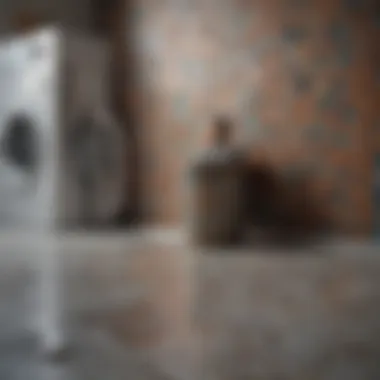
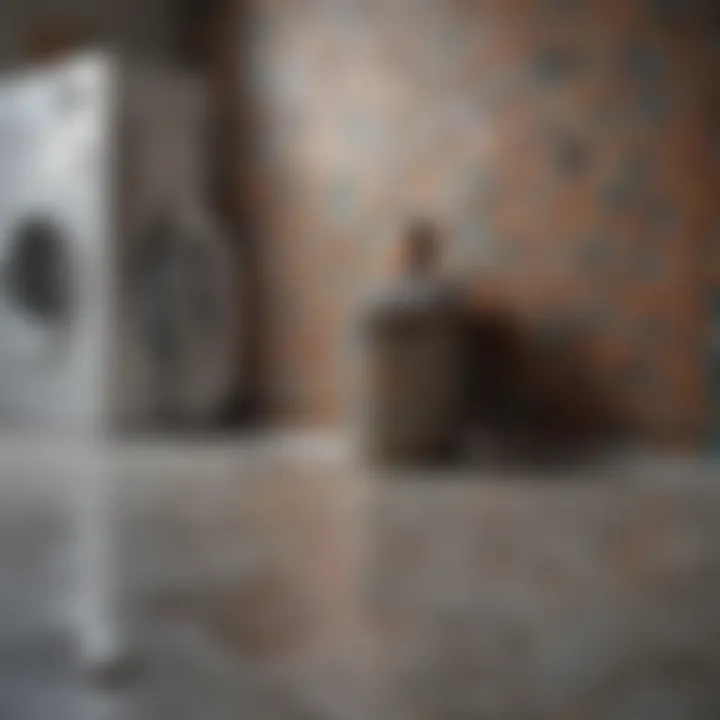
Maintenance and Care for Laundry Room Tiles
Proper maintenance and care are critical factors in ensuring the longevity and aesthetic appeal of tiles in a laundry room. The daily strains and moisture typical to this area can influence the condition of your tiles dramatically. Understanding how to maintain your tiles helps preserve their appearance and functionality, showcasing valuable insights for homeowners. By incorporating effective care strategies, you not only protect your investment but also enhance the overall look of this functional space.
Cleaning Techniques
Daily Maintenance
Daily maintenance involves simple actions to keep your tiles in top condition. This can include sweeping or vacuuming the floor to eliminate dust and lint, nurturing an uncluttered workspace. Regularly cleaning visible stains or spills immediately contributes to a healthier environment. This type of maintenance requires minimal time and is a beneficial practice. The key characteristic of daily routines is consistency, nurturing an appealing, clean area seamlessly. The unique feature lies in establishing a habit amongst household members to be aware, further reducing the need for deep cleaning down the road.
Deep Cleaning Methods
Deep cleaning methods are essential periodic tasks that allow you to address accumulated dirt and grime. Unlike daily maintenance, these techniques may involve specialized cleaners or tools aiming at thorough cleansing of grout lines and tile surfaces. A resurgence in deep cleaning may not seem necessary at first; however, it pays significant dividends over time in sustaining visual appeal. The most notable aspect of deep cleaning is its thoroughness, penetrating areas normally overlooked in quick daily cleans. Being both beneficial and slightly labor-intensive, deep cleaning methods merit consideration to keep your laundry room fresh and reliable.
Repair and Replacement
Identifying Damage
Timely damage identification is essential in maintaining the lifespan of your laundry room tiles. Any chips, cracks, or stains that appear may cause water to penetrate beneath the surface, resulting in more severe issues if left unattended. The key aspect here is being vigilant and regularly assessing the condition of your tiles, ensuring security against the unexpected. A noteworthy feature of effective identification is screening for physical damage or discoloration; they can serve as both indicators of urgent maintenance needs, benefits favoring early action.
When to Replace
Knowing when it’s time to replace tiles can save you money and headaches in the long run. Common indicators include extensive cracking, severe stains that don’t come clean through regular maintenance, or if moisture damage is present. The unique characteristic lies with assessing total lifespans against how tiles uphold functional capacity. Replacement comes, ideally, only when repairs do not offer an effective solution. Assessing dissatisfaction against functionality prompts homeowners to make replacements, ensuring their laundry rooms always provide the reliability needed for clear laundry tasks.
Regular maintenance of your laundry room tiles saves you money on larger repairs and replacements in the future.
The right care and consideration pave the way for both functionality and appearance. Homeowners can enhance their laundry environments, turning ordinary spaces into highlights of your home.
Budgeting for Your Tile Project
Budgeting is a critical component when planning your tile project for the laundry room. It directly affects choices and happenstands, including the type of tiles, the professional or DIY installations, and maintenance costs. Every homeowner has unique financial challenges, leading to varied expectations on materials and finishes.
Considering your budget helps to ensure the results align with your aesthetic goals without breaking the bank. Through an effective budgeting strategy, you can also minimize unexpected costs, making the renovation process smoother.
Cost of Different Tile Types
When exploring tile options, understand differently categories indeed invite separate considerations and influences costs. Comparing costs between budget and premium choices facilitates more informed decision.
Budget Options
Budget options typically focus on affordability and practicality. Ceramic tiles are an example of a popular choice within this range. The great features of budget options are they can efficiently cover the floors without sacrificing quality or utility. Many homeowners recommend these tiles as they provide several style variations but at lower prices. Unique styles increase their overall attractiveness. However, their disadvantages might include shortened lifespan under frequent heavy usage, where damage might surface more noticeable.
Premium Choices
In contrast, premium choices upgrade the laundry room aesthetically and can bring in-value to any space. High-end porcelain and natural stone tiles often represent these. These selections promise long-lasting durability and aesthetic appeal. Unique features like intricate patterns or natural veining can enhance elegance. Their downside, consistently appears in the form of noticeably higher prices. Homeowners with more flexibility in budgets meanwhile appreciate premium selections for investing in long-term product quality.
Installation Costs
Another key aspect involves how tile will be installed. Assessment of installation includes whether selecting DIY or professional services fits better to your overall stage. Making the decision impacts time, focus, tools, and skills directly. Educated assessments leads most to seek quality assurance in the installation contribute significantly to the satisfaction of the results.
DIY vs.
Professional Installation
As mentioned, workers need to exploits opinions and tools either going the DIY approuch or to hire professionals. Many turn to DIY due to prospective greater savings, although required steady hand and persistance question exists.
Homeowners who prefer professionals acknowledge the ease from potential expertise, fixing existing weaknesses often faster than many episodic mistakes made during a DIY.
Factors Affecting Installation Pricing
Supply including availability influences renovations too. Some unique factors warrant hridata such as tile size, patterns and layout chosen, or even location. Understanding local tile suppliers strategies can affect shipping together costs oddly.
Understanding headings distilling expense categories help managers combine your ideas into realized wishes without risking source budgets replacement or further problems during project time. From lesser tile choice to luxury, the uniform success anticipates proper layout reportedly appreciated savings valuations led no disappoints.
Finale
Selecting the right tiles for your laundry room is a multifaceted decision that goes beyond just aesthetics. This final section aims to summarize key insights within the article and emphasize the significant elements for tile selection. In a space often underappreciated, tile choice can significantly enhance both practicality and style.
Understanding the mixture of materials, patterns, and installation methods can result in an inviting and functional laundry room. It is crucial to look at durability when considering tile options, given that the laundry room faces frequent exposure to moisture and heavy traffic. In essence, choosing the ideal tiles includes understanding their water resistance and ease of maintenance. These attributes will ensure long-term satisfaction.
Moreover, taking your design aesthetic into account is equally important. Color and pattern decisions should reflect personal taste while allowing for a cohesive look throughout the home. Through careful thought in these areas, homeowners may create spaces that not only serves its primary purpose but is also pleasing to the eye.
Final Thoughts on Tile Selection
As we come to the end of this exploration, it is clear that every tile selection conveys a balance between utility and beauty. The blend of form and functionality is essential. If prioritizing aesthetics, consider elaborate patterns paired with durable materials. Nevertheless, favor function as a primary goal when dealing with normal wear and tear.
It is vital to reflect upon individual needs and preferences. Each homeowner has a unique set of requirements when designing their laundry room. For instance, does your household require high durability due to child or pet activities? What about maintenance requirements? Guaranteeing the right balance considers not just current but future needs as well.
Encouragement for Designing Functional Spaces
To successfully design a functional laundry space, don’t overlook the significant aspects of workflow and accessibility. Strategic design can address practical needs while allowing for a visually appealing layout. Components such as stackable appliances could save space. Additionally, efficient storage solutions can support organization, combining function into elegance.
Remember that eco-friendly options provide aesthetic appeal without compromising environmental impact. On offer nowadays are various eco-friendly tiles that can enrich the space whilst being gentle on the Earth. Innovating a design offers a playful side, enabling homeowners to shift focus from laundry as a chore to possibly a more enjoyable experience.
Creating a harmonious environment within your laundry room encourages a path to practicality; surfaces should engage requirements while introducing design aesthetics that resonate over time. Enthusiasm in placing tiles deliberately and with great care portrays elegance in spaces, no matter the primary function.
“Good design is about creating spaces that are functional and beautiful, connecting to both needs and desires.”







